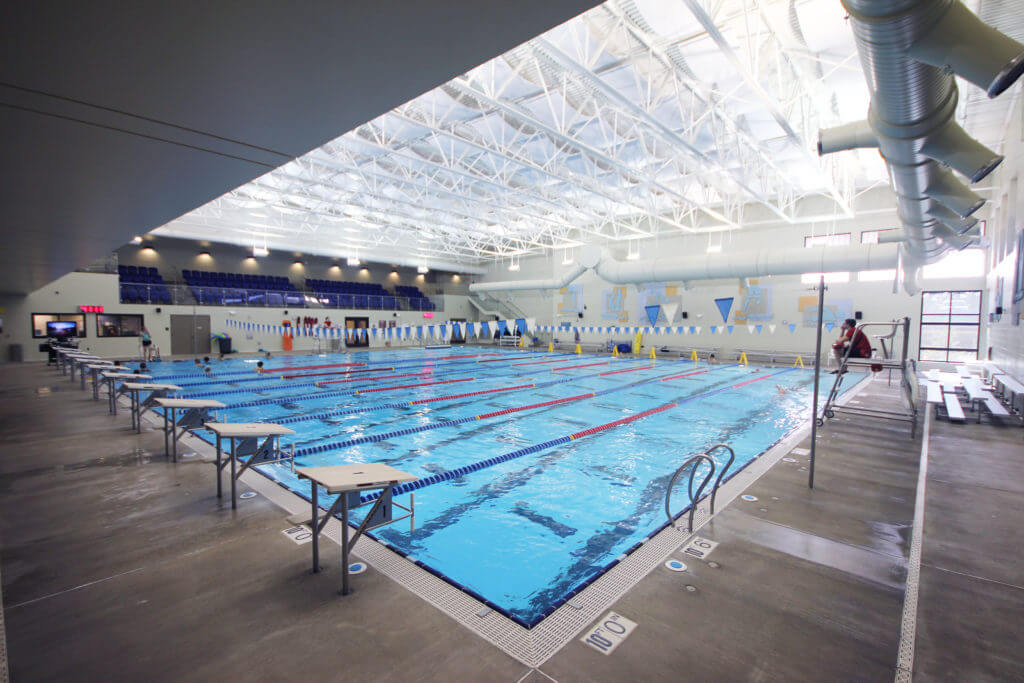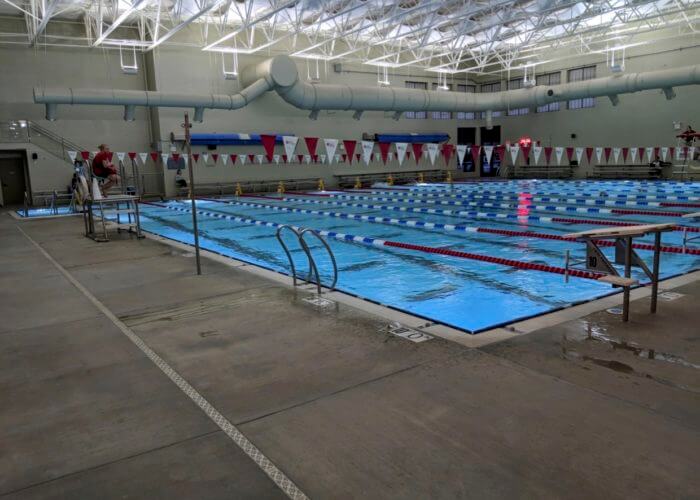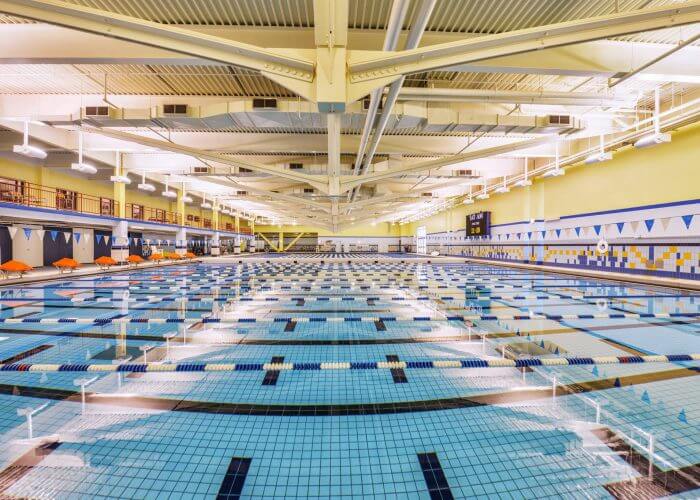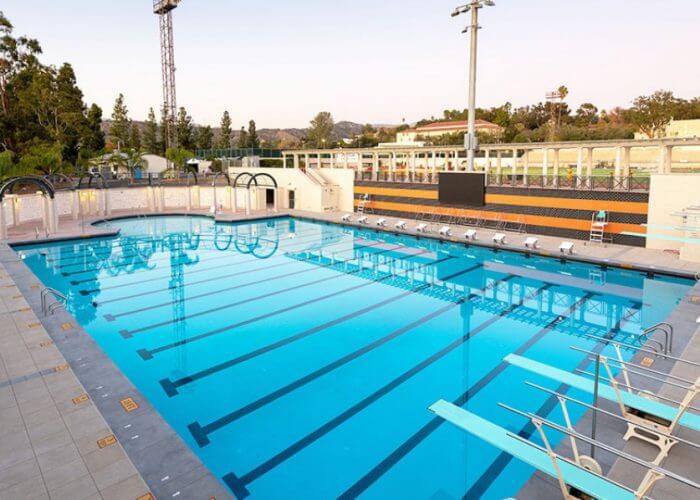COVID-19 and Environmental Considerations for Aquatic Sports

COVID-19 and Environmental Considerations for Aquatic Sports
The following paper is by Mark Collingham, M.S. Chemical Engineering, and head coach of Kroc/CDA Water Polo Club in Coeur d’Alene, Idaho. He may be reached at mark.collingham@gmail.com
The coronavirus (SARS-CoV-2 or covid-19) pandemic of 2020 has affected many areas of life throughout the world, including the ability of athletes to continue participating in their various sports. There have been and continue to be a number of questions about the safety of practicing sports in the midst of the coronavirus situation. Nearly all sports programs shut down in the spring of 2020 and many of those continue to remain shut down or have re-opened with limited practices. A few sports programs decided to restart within a few months, recognizing that having athletes remain at home with little outlet to practice could have other negative consequences. Staying in shape is especially difficult for those who participate in aquatic sports as there are few land based activities that can replicate the motions and resistance provided by water. Sports and related athletic activities provide a number of benefits beyond just exercise. They allow athletes to work on improving their abilities, provide students an opportunity to learn to work and interact with others, give a social outlet and variety of other benefits to athletes’ minds and bodies.
In recognition of this, our local swim and water polo programs elected early on to provide an opportunity for students to restart training in a controlled environment. For a variety of reasons, it was reasoned that our programs could provide a safe environment for the athletes to practice. This was thought to be preferable than have our athletes sit at home and possibly engage in other activities that might not be as safe or controlled.
Our facility has been running practices on a daily basis since June 1st for both swimmers and water polo players without any known transmissions on the team (as of November 2nd). During this time, two swimmers were determined to have contracted the virus from contacts outside of swimming (one contracted it from a coworker and the other from a family member). One of the swimmers had participated in at least one practice while likely infected. However, after testing all swimmers on the swim team who had contact with him, no additional cases were found. The population of our local community (Kootenai County, Idaho) from which our program draws athletes is 165,000, with a mix of small town, suburban and rural areas. As of November 2nd, the county has had 4,509 coronavirus cases or a case rate of 273 per 10,000, which is about the same as the current reported national average of 280 per 10,000. Approximately 100 swimmers and 50 water polo players have been participating anywhere from 3 to 6 practices/week on the local clubs. In addition, from early August through the end of October, four additional high school swim teams of 32 swimmers each also conducted practices at the facility. Swimmers were limited to 5 swimmers/lane initially and the water polo group was limited to a maximum of 25 players/practice. Swim team practices were later allowed to increase to 8/lane while water polo practices have continued to be limited to 25/practice. The practice area for water polo has ranged from 4 lanes (272 yd2) to 7 lanes (477 yd2).

Air handling ductwork at the Kroc Center pool. Photo Courtesy: Kroc Center CDA
Swimmers and water polo players were spread out in the pool, as is normal during swimming and water polo practices when conducting various drills such as passing, shooting and swim sets. While normally separated when swimming or practicing ball skills, swimmers would congregate at the ends of the pool
after sets and water polo players would group together for discussion and explanations of skills. Due to the difficulty of being understood, coaches sometimes do not wear masks once practices begin, but do attempt to maintain social distancing during practices and wear masks prior to and after practice.
Transmission and Suppression in the Pool Environment
There are a number of reasons why pool environments are likely to be inhospitable to the transmission of upper respiratory diseases, of which the current covid-19 virus is one. These reasons will be reviewed below. While each of these factors may individually help to reduce transmission, it is the cumulative effect of these pool environment factors which may create an environment that is inhospitable to the transmission of covid-19 and related viruses.
Warm and Humid Pool Environments
Since early in the covid-19 pandemic, it was theorized by many experts that warm and more humid environments would not be as conducive to the transmission of the coronavirus as compared to cool and dry environments. As anyone who has entered a pool area has experienced, pool areas are normally maintained relatively warm and humid for the comfort of users. Most pools follow ASHRAE recommendations of keeping the air temperature slightly above the pool temperature and a relative humidity in the range of 50%. For our facility, this translates to a nominal pool temperature of 82°F, an air temperature of 82-85°F and a relative humidity of 35-55%. While correlation between transmission rates and temperature/humidity is not proven, it is generally thought that the higher temperatures and humidity levels experienced in standard pool environments should reduce the likelihood of transmission.
Facility Air Circulation
Several articles have discussed the importance of providing proper air circulation as a means to reduce transmission of covid-19. This includes maintaining a significant air turnover rate (four to eight times/hour), introduction of a significant fraction of fresh air and the use of HEPA air filters. The pool area at our facility had been designed with a high air turnover rate and includes 50-60% fresh air. The air controls also include significant filtering of the air (MERV rating 8-10) to filter out smaller particles. MERV filters in this range can capture 85% or more of particles with a diameter of 3-10 microns. This would include a significant amount of the respiratory droplets generated from sneezing, coughing and talking, though would not include any aerosols that are generated. Studies of infection rates of covid-19 indicate that prolonged close contact in confined spaces leads to significantly greater infection rates. Conversely, efforts to make contact between individuals short in duration, physically distant, and conducted in open spaces should lead to lower rates of infection. By turning the air over quickly, filtering small particles and providing a high percentage of fresh air, the indoor pool environment may be able to replicate the lower infection rates observed in outdoor settings.
Inactivation by Chlorinated Pool Water
Chlorine is commonly used in pools to control a wide variety of organisms, including viruses, bacteria, protozoa and fungi. While studies focusing on the effectiveness of chlorine on the specific covid-19 do not appear to have been completed, the effectiveness of chlorine on other SARS-CoV viruses has been examined. A study in 2005 found that a similar coronavirus was inactivated within 10 minutes in water containing a free chlorine level of 0.4ppm. The study also showed that nearly half of the coronavirus was inactivated within 1 minute at the same chlorine concentration. It is expected that chlorine is similarly effective in inactivating covid-19 within the pool environment. At our facility, the free chlorine level is kept in the range of 2.0-2.5ppm with a pH of 7.5. In addition to the chlorine activity, the pool water is filtered and ran through a UV chamber to further eliminate viral and bacterial organisms. These disinfection practices are expected to quickly inactivate any coronavirus that may be introduced to the pool. When swimming or playing water polo, athletes normally experience considerable rinsing of the mouth and dilution of saliva when swimming or otherwise vigorously moving in the water. Since the pool water contains low levels of chlorine, any coronavirus in the mouth would also be inactivated. This washing or rinsing action would be expected to inactivate any coronavirus contained in the mouth, throat and nose surfaces during the athlete’s time in the pool.

Photo Courtesy: Chelsea Piers Connecticut
Another concern of coaches and athletes is whether the close contact and inadvertent spray from another swimmer or water polo player could cause transmission in the pool. While this is certainly a valid concern, the rapid inactivation of the coronavirus in the chlorinated pool water along with the rinsing and disinfection action in the mouths, throats and noses of the athletes may significantly reduce transmission in the event that an infected player is participating in a practice. Furthermore, transmission of covid-19 is generally understood to be conducted via aerosols or other very small droplets that are later breathed in by others, rather than the inactivated large drops expelled from an athlete’s mouth during swimming or other aquatic activities.
Dilution by Pool Water Volume
Beyond the disinfection rendered by chlorination of the pool, the large volume of water in pools will greatly dilute any virus particles expelled into the pool water. Assuming a swimmer expels 100 ml of saliva into a 25m by 25m x 2m pool during a workout, the resulting solution would eventually be diluted by a factor of over 12 million. While the saliva wouldn’t immediately be diluted to this extent, considerable dilution will occur immediately upon contact with the pool water and become extremely diluted within seconds. Any expelled viruses would be diluted to such low levels as to be inconsequential to other athletes in the pool, even without the disinfection effects of chlorine.
Washing of Upper Respiratory Tract
Coronaviruses, including covid-19, tend to reside in the upper respiratory tract, including the mouth, tonsils and back of the throat. Anything that reduces the quantities of virus in these areas may assist in reducing transmission and resulting infections. Gargling has been used in Japan and other societies for many years as a method of both reducing disease transmission and relieving symptoms of those infected. Testing of the effectiveness of gargling has shown that daily gargling can significantly reduce upper respiratory tract infection rates. Swimmers and water polo athletes know that working out in the water involves considerable exchange of pool water with the mouth. When swimming, a small amount of pool water normally enters the mouth with each breath and then is soon expelled back into the pool.
While this does not exactly replicate the gargling action, the repeated washing of the mouth does function to wash out the mouth and to a lesser extent, other areas of the upper respiratory tract. Anyone who has worked out in a pool in which the pool chemistry is slightly off has probably experienced this in the form of “cotton mouth”. Furthermore, gargling is a very short procedure (less than a minute) whereas competitive swimming and water polo involves nearly continuous washing of the mouth for an hour or more. In addition, pool water is generally treated to a higher chlorine level than the tap water commonly used for gargling. While the majority of pool water that enters the mouth is quickly expelled back into the pool, small quantities are also swallowed. This rinsing action would be expected to further dilute and inactivate any virus in exposed regions of the upper respiratory tract.
Other Pool Facility Considerations
While the pool and pool area environment itself is thought to be relatively safe due to the accumulation of the above reasons, there is concern about the possibility of transmission either before or after practices. Changing areas often do not have as high an air turnover rate as the main pool area and can be both crowded and noisy. At our facility, swimmers and players are asked to change into and out of their suits at home and to minimize use of the changing areas to times when it is necessary (e.g. if going to work or another event where changing out of a swimsuit is difficult or impossible). Swimmers are also excused from practices at different times in order to minimize the number of athletes in the changing areas at the same time. In addition, swimmers and water polo players are expected to wear facemasks whenever in the pool areas and close to other people but not practicing.
Initially, water polo practices consisted of just swimming, passing and shooting drills. As time went on in which the program did not experience any coronavirus infections, drills in which players came in closer contact with each other were added. These included adding defensive players to shooting drills, limited hole work (e.g. short sessions with limited defense), offensive sets with defense, 6 on 5 drills and occasional scrimmaging – generally limited to no more than 15 minutes/practice. Practices for younger players were an hour each, three times/week. High school practices were either 1.5 or 2 hours each and were run 4 times/week. Practice times were reduced to one practice each for several weeks in August due to limited pool availability but returned to the earlier schedule in September. Four other high school swim teams of 32 swimmers each also used the pool for practices and dual meets from early August through the end of October, following the protocols and maximum number of swimmers allowed per lane as described earlier. Swim practices ranged from 1 to 11⁄2 hours each. No coronavirus infections have been reported amongst any of the teams using the aquatic facility to date.
Environmental Considerations for Transmission
Transmission of covid-19 and other coronaviruses increases when the environmental and social circumstances make the transmission of the virus occur more easily. Conversely, it has become well established that infection rates are significantly lower when outdoors, when people are socially distant and in areas where there are few people. The World Health Organization (among others) has simplified this into the catchphrase “The Three C’s”, these being Crowded Places, Close-Contact Settings and Confined and Enclosed Spaces.

Photo Courtesy: Oxy Athletics
If a facility can design practices or other events to avoid the above three situations, it can assist in reducing the likelihood of transmission. For aquatic facilities, limiting the number of people allowed at the practice or event is important. Our program has done this by limiting the number of swimmers or players at a given practice. Furthermore, parents and other spectators are requested to not attend practices. Reducing close-contact situations is done by having swimmers spread out during swim sets. For the majority of the practice, the 5-8 swimmers are spaced out over 200 ft2 of pool area (40-25 ft2 swimmer) and water polo players have at least 800 ft2/25 players = 32 ft2/player available. This compares to the generally accepted 6 feet of social distancing (roughly equivalent to 36 ft2/person). There are times where the group is brought together for a few minutes for instruction, but these are kept to a minimum, usually no more than 5-15 minutes per practice and limited to a few minutes at a time over 11⁄2 hours. In regards to confined spaces, while the facility is indoors, the volume within the pool area is very large, with high ceilings and additional areas for bleachers and stadium seating. The total volume within the pool enclosure is approximately 350,000 ft3. Assuming both practices are going on at the same time with full attendance (32+25 athletes total), along with 4 coaches and 2 lifeguards, the pool area provides over 5,000 ft3 of air volume/person. This compares to a standard bedroom air volume of 1,200 ft3. This large volume of space in combination with a high air turnover and fresh air introduction rates approaches an outdoor environment condition, making transmission of virus particles from one individual to another increasingly difficult.
Conclusion
As of the writing of this article, both the water polo and several swim programs have not experienced any transmission of coronavirus within the teams. As noted earlier, the athletes in the programs have experienced only two outside cases of coronavirus and have not had any known transmissions from practices. In an area with a community infection rate of 273 per 10,000 (as of Nov. 2nd, 2020), one would expect approximately 8 cases among the 278 athletes (228 swimmers and 50 water polo players) (though infection rates amongst children and young adults is less than the general population). This also assumes that all of the swimmers participated throughout the 5 month period that the pool has been open for practices, which is not the case for all of the swimmers.
The numbers above reflect only confirmed cases. It is often estimated that there are ten times or more actual cases than confirmed cases. In these cases the infections are either asymptotic or have very mild symptoms. Due to the mild or non-existent symptoms, the individual is never tested. Assuming this is the case, we would expect approximately 76 cases amongst the athletes. To have 278 swimmers and water polo players not show any transmission strongly supports the idea that the pool environment is hostile to transmission.
It should be noted that the majority of the athletes have not been tested for coronavirus and it is possible that some individuals have been infected but remained asymptomatic. However, if the pool environment was conducive to transmission, we would have expected a number of athletes and/or their families to have become infected and shown symptoms or find out through outside testing that they had been infected. While the fact that we have not experienced any known transmissions in the pool environment does not prove that it will not happen, it does give considerable support to the case that the factors described above are assisting in reducing transmission during swim and water polo practices. While individually anecdotal, the accumulated evidence of lack of transmission in hundreds of individuals over nearly five months of practices indicates that the aquatic environment is significantly less conducive to coronavirus transmission in comparison to other public environments such as choirs, bars, restaurants and other gatherings of people. Numerous transmissions have been reported in these environments after just a single gathering or event. This compares to our facility having no known transmission among the 278 athletes who have participated in hundreds of practices and tens of thousands of cumulative possible exposure hours over the last 5 months. Going forward, as other programs consider re-opening their pools to swimmers, water polo players and other athletes, the above considerations and results from our experiences may be helpful in their decision making.
The observations and opinions expressed in this article are those solely of the author.




Amy Albiero
Good work thankyou
How about write an article that definitively promotes opening indoor pool facilities? I watched the ISL meet the other day and I thought of all the swimmers out there who still can’t swim because of the narrative that has been perpetrated that indoor pools are not safe. What a travesty. I am so tired of seeing articles that day may or might. Pools should open and all swimmers should have the opportunity to swim if they want to but this is not the case.
As a father of 12 year old, who other than swimming is glued to his computer, I am extremely frustrated by a medical establishment that does not distinguish indoor winter sports that are cold and dry from swimming in chlorinated water. New Jersey is shutting down tomorrow (12/4) until January. The governor’s medical advisor reads as clueless.
Thank you for the rigorous treatment.
Can someone please pass this to the #NCAA and all those conferences (#NESCAC, #Midwest, #SCIAC to name a few), that think cancelling swim is a good idea. Clearly it is not necessary.
Thank you for sharing all of your safe practices and your program’s commendable efforts to get swimmers and polo players back to training.
Your procedures are backed by science and you are making such a positive impact on the physical, mental and economic health of your community.
Here’s to hoping that our state of NJ and all states and countries will follow your dedication and actions.
Thank you. I am a 65 year old woman who serves as a house mother to a sorority house of 68 women. Covid ran through our house a few times fall semester 2020. I am a daily Y swimmer and have thought that maybe being in a vat of chlorinated water every day (one person per lane) for 60-75 minutes might be keeping me a bit immune to the virus. Your article somewhat validated my thinking on this subject. I do know my mental health is better due to my daily swim. So happy the Y pools are open in my community. Thank you!